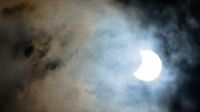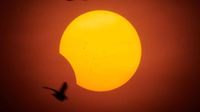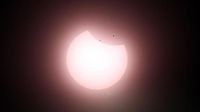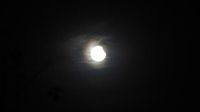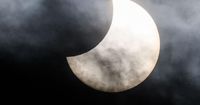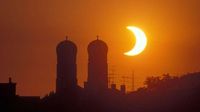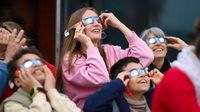On March 29, 2025, a spectacular partial solar eclipse captivated observers across Germany, particularly in Berlin and Brandenburg. This celestial event began at 11:32 AM and reached its peak at 12:20 PM, with the moon covering approximately 15.3 percent of the sun. The eclipse concluded at 1:08 PM, allowing many to enjoy a rare glimpse of this astronomical phenomenon.
The partial solar eclipse provided a unique opportunity for enthusiasts and casual observers alike to witness the moon's shadow cast across the sun. Notably, the best viewing conditions were reported in the western and northwestern parts of Germany, where clearer skies allowed for a more vivid experience. In Berlin, despite some light cloud cover, the sun was visible during the peak of the eclipse.
Locations such as the Archenhold Observatory in Treptower Park, the Wilhelm-Foerster-Sternwarte in Schöneberg, and the Zeiss-Großplanetarium in Prenzlauer Berg became popular spots for viewers. These venues hosted special events, including live streams and public gatherings, where attendees could safely observe the eclipse through telescopes and specialized glasses.
In Brandenburg, similar events took place, with several observatories and planetariums offering free or low-cost opportunities to view the eclipse. The Sternwarte in Bernau, Sternenfreunde Eberswalde, and the Urania-Planetarium in Potsdam were among the many locations that welcomed visitors. Educational talks were also held to explain the science behind solar eclipses, making it an engaging experience for people of all ages.
As excitement built leading up to the event, experts reminded the public of the importance of eye safety during solar observations. Astronomers and medical professionals warned against looking directly at the sun without proper protection, as even brief exposure could lead to serious retinal damage. Only certified solar eclipse glasses, which can be purchased at various retailers, offer the necessary protection.
Additionally, the event sparked interest in the next partial solar eclipse, scheduled for August 12, 2026, when nearly 85 percent of the sun will be obscured. For those who missed the 2025 eclipse, this upcoming opportunity promises an even more dramatic spectacle.
In the days following the eclipse, many shared their experiences and photographs online, showcasing the beauty of this cosmic event. The Stiftung Planetarium Berlin, which played a significant role in organizing viewing events, reported a high turnout and expressed satisfaction with the public's enthusiastic response.
While the eclipse was a highlight for many, it also served as a reminder of the intricate dance between the earth, moon, and sun, illustrating the wonders of our solar system. As Tim Florian Horn from the Stiftung Planetarium Berlin noted, "The solar eclipse is a great way to engage the public with astronomy and spark interest in the sciences." This sentiment echoed throughout the various events held across the country, emphasizing the importance of scientific literacy and community engagement.
As people returned to their daily lives, discussions about the eclipse continued, fueling curiosity about future astronomical events. The next total solar eclipse visible from Germany will not occur until September 3, 2081, making the upcoming partial eclipse in 2026 a highly anticipated occasion for skywatchers.
In summary, the partial solar eclipse on March 29, 2025, provided a memorable experience for many across Germany. With clear skies in some regions and organized events in others, it was a day that brought people together to marvel at the wonders of the universe. As we look forward to the next eclipse, the excitement and anticipation will surely continue to grow, reminding us of the beauty of our celestial surroundings.
